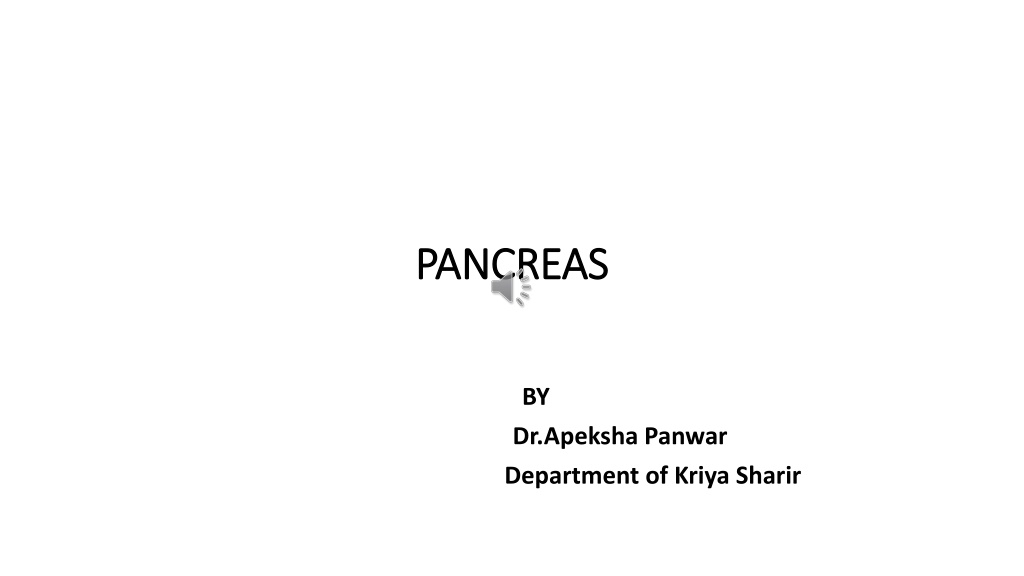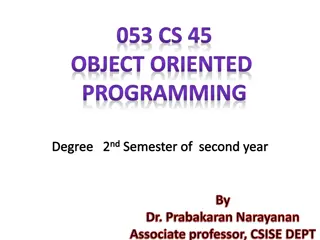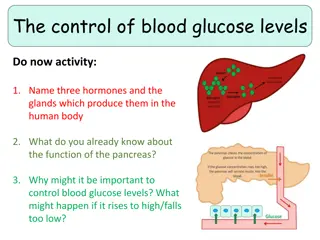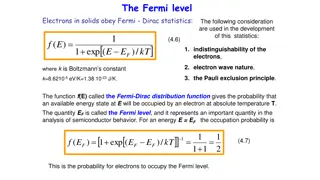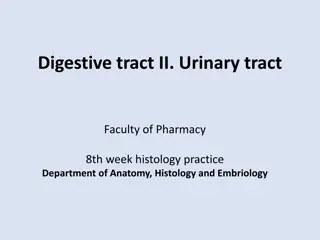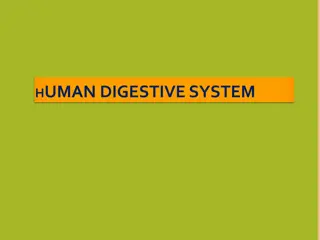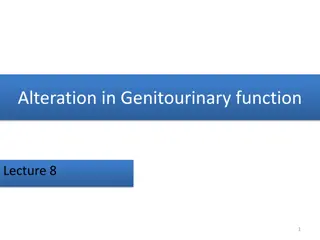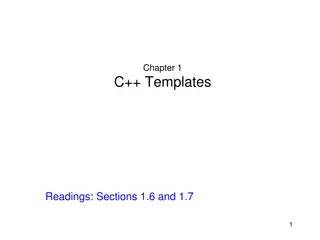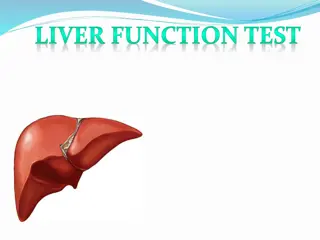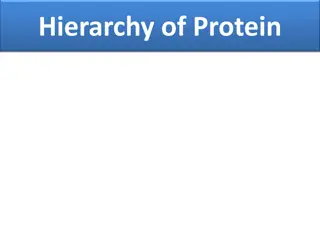Comprehensive Overview of Pancreas Function and Structure
Pancreas is a vital organ in the abdomen with dual exocrine and endocrine functions. As an exocrine organ, it secretes digestive enzymes and bicarbonates into the duodenum for food breakdown. In its endocrine role, the pancreas regulates blood sugar levels by secreting insulin, glucagon, somatostatin, and polypeptide. The pancreas plays a crucial role in the digestive system through its exocrine function involving the secretion of pancreatic juice rich in enzymes. Additionally, its endocrine function is carried out by the Islets of Langerhans, consisting of different cell types that secrete various hormones. Pancreatic juice, with a highly alkaline nature, contains water, enzymes, and inorganic compounds essential for digestion. The mechanism of pancreatic bicarbonate secretion further highlights the pancreas's role in maintaining digestive health.
Download Presentation

Please find below an Image/Link to download the presentation.
The content on the website is provided AS IS for your information and personal use only. It may not be sold, licensed, or shared on other websites without obtaining consent from the author. Download presentation by click this link. If you encounter any issues during the download, it is possible that the publisher has removed the file from their server.
E N D
Presentation Transcript
PANCREAS PANCREAS BY Dr.Apeksha Panwar Department of Kriya Sharir
INTRODUCTION INTRODUCTION Pancreas is an organ located in the abdomen It is a dual organ having both exocrine and endocrine function. As an exocrine part it secreates pancreatic juices into the duodenum through thr pancreatic duct. This juice contains bicrbonates which neutralizes acid entering the duodenum from the stomach and digestive enzymes which break down carbohydrates , proteins and fats in food entering the duodenum from the stomach. As an endocrine part it functions mostly to regulate blood sugar levels, secreating the hormone Insulin, Glucagon, Somatostatin and Polypeptide.
EXOCRINE FUNCTION OF PANCREAS EXOCRINE FUNCTION OF PANCREAS Pancreas plays a vital role in the digestive system. It does this by secreating a fluid that contain digestive enzymes into the duodenum, the first part of the small intestine that receives food from the stomach. The cells that do this are arranged in clusters called Acini. Secreations into the middle of the acinus accumulate in intralobular ducts which drain to main pancreatic duct which drain directly to duodenum. The cells in each acinus are filled with granules containing the digestive enzymes , these are secreated in inactive form called zymogens.
ENDOCRINE FUNCTION OF PANCREAS ENDOCRINE FUNCTION OF PANCREAS The endocrine functions of pancreas is performed by Islets of Langerhans. Human pancreas contain about 1-2 million islets. Islets of Langerhans consist of four types of cells: 1-Alpha cells- which secreate glucagon 2-Beta cells- which secreate Insulin. 3-Delta cells- which secreate somatostatin. 4-PP cells which secreate Pancreatic Polypeptide
PANCREATIC JUICE PANCREATIC JUICE Volume: 500-800 ml/day Reaction: Highly alkaline due to high concentration of bicarbonates. Specific gravity: 1.010-1.018 Composition: It contains 99.5% water ,0.05% solids Organic compounds: mainly enzymes, amylase,lipase , protease and trypsin inhibitor. Inorganic compounds: Sodium, potassium, calcium, magnesium, zinc and bicarbonates.
MECHANISM OF PANCREATIC BICARBONATE MECHANISM OF PANCREATIC BICARBONATE SECREATION SECREATION
FUNCTIONS OF PANCREATIC JUICE FUNCTIONS OF PANCREATIC JUICE Its main role is in digestion of proteins and lipids. It has mild digestive action on carbohydrates. Digestion of proteins is carried out by proteolytic enzymes Trypsin and chymotrypsin. Trypsin also helps in digestion of milk and in blood clotting.
STRUCTURE OF INSULIN STRUCTURE OF INSULIN Insulin is a small protein, and has a molecular weight of 5808. It is composed of two amino acids connected to each other by disulphide linkages. When the two amino acids are split apart the functional activity of the insulin molecule is lost. Insulin is synthesized in the beta cells by the usual cell machinery for protein synthesis, beginning with translation of the RNA by ribosomes attached to the endoplasmic reticulum to form Preproinsulin. These preproinsulin is then cleaved in the endoplasmic reticulum to form a Proinsulin and consisting of three chains of peptides A,B,C . Most of the proinsulin is further cleaved in the golgi apparatus to form insulin, composed of the A and B chain connectedby disulphide linkages and the C chain peptide called connecting peptide. The insulin and C peptide are packaged in the secreatory granules and secreated in the secreatory granules and secreated in equimolar amounts. When insulin is secreated into the blood it circulates almost entirely in an unbound form, it has a plasma life that averages about 6 minutes, so it is mainly cleared from the circulation within 10 to 15 minutes.
ACTIONS OF INSULIN ACTIONS OF INSULIN On carbohydrate metabolism Insulin is the only antidiabetic hormone secreated in the body. It reduces blood sugar levels by following mechanisms: 1- Increasing transport and uptake of glucose by the cells. 2-Promotes peripheral utilization of glucose. 3-promoting storage of glucose- Glycogenesis, 4-Inhibiting Glycogenolysis. 5- Inhibiting gluconeogenesis. On protein metabolism Insulin facilitatesthe synthesis and storage of proteins and inbits cellular utilization of proteins. On Fat metabolism Insulin stimulates the synthesis of fats and storage in adipose tissue.
GLUCAGON GLUCAGON It is a hormone secreated by the alpha cells of the islets of Langerhans, when the blood glucose concentration falls. It is a large polypeptide and has a molecular weight of 3485 and is composed of a chain of 29 amino acids. Actions of glucagon It increases the blood sugar level . It increases peripheral utilization of lipids. It facilitates conversion of proteins into glucose. It inhibits secreation of gastric juice. It increases secreation of bile from liver
Functions of Glucagon Functions of Glucagon 1-On Carbohydrate metabolism It increases Glycogenolysis in liver. It promotes gluconeogenesis in liver. 2-On Protein Metabolism It increases transport of amino acids to liver which are essential for gluconeogenesis. 3-On Fat Metabolism It has lipolytic and ketogenic effect on fat molecules.
THANK YOU THANK YOU
